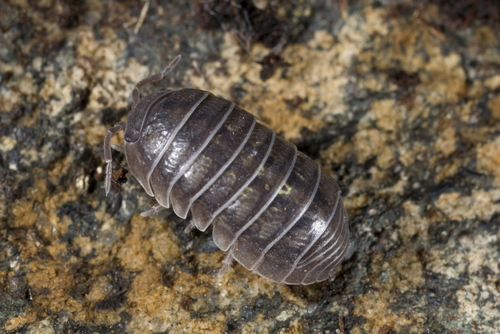Sowbugs: Crustaceans Among Us
By Chris Williams on February 24, 2013.

Each year we get a number of calls related to Sowbugs and Pillbugs. These ubiquitous little creatures are the only crustaceans that are able to live out of water. In fact, sowbugs and pillbugs actually have gills similar to crabs and lobsters. Due to their close relationship to ocean dwellers, sowbugs and pillbugs require a moist habitat. Scientifically known as Isopods, sowbugs and pillbugs feed on decaying organic matter, returning nutrients to the soil. Beneficial members of the web of life, they also serve as food for spiders, beetles, and other members of the food chain. Sowbugs and pillbugs are not considered structural pests, although they sometimes enter buildings in search of suitable living conditions.
Sowbugs and pillbugs are small light to dark gray, oval shaped animals with 7 pairs of legs. Both have a small head, segmented antennae, the abdomen covered in hard overlapping plates. Sowbugs have a pair of tail-like appendages lacking in pillbugs. One sure way to distinguish sowbugs from pill bugs is that pillbugs are able to roll up into a ball when disturbed. Sowbugs are unable to curl up completely. Females deposit their eggs in a pouch on the underside of the body, where the embryos develop and emerge in 22-44 days. There may be as many as two generations per year, with winter stopping all activity until the temperature warms up. Females may live for 2 years.
Sowbugs and pillbugs live in the soil, leaf litter, under rocks, and logs. Wherever organic matter is found, sowbugs and pillbugs will be there. They live in all but the coldest places on earth. In the constant search for moist habitat, sowbugs and pillbugs migrate to areas with ideal conditions. Weather events like drought, flooding, and rapid temperature swings may drive them into structures. For instance, when the water table rises below a structure, sowbugs and pillbugs will flee the rising waters and come up through cracks in foundation elements. Hot dry weather will also force them into cooler damp basement areas to avoid desiccation. Although they don’t damage homes, great numbers of sowbugs and pillbugs can be a concern to homeowners. In most cases they either return to their preferred habitat, or simply dry up on the floor. The most common encounter with sowbugs and pillbugs is in the soil, while planting or digging. Sometimes a pest of ripening fruit and vegetables, steps can be taken to reduce moisture in the garden, and around the home. A barrier of crushed stone adjacent to the foundation, trimming shrubs away from the house, and minimizing the use of organic mulches will also decrease moisture and habitat. Watering gardens and lawns in the morning will allow wet areas to dry before nightfall, also limiting potential moisture around the home. Sealing up cracks in the foundation and other potential entry points will also help reduce sowbug and pillbug activity. As a last resort, commonly used pesticides are available for use by licensed Pest Control Professionals. In most cases pesticides are note needed to control sowbugs and pillbugs.